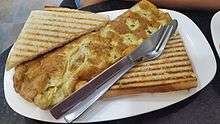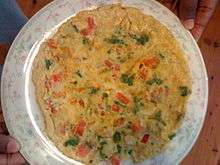Omelette
 | |
| Place of origin | France |
|---|---|
| Main ingredients | Eggs, butter or oil |
|
| |


In cuisine, an omelette or omelet is a dish made from beaten eggs quickly fried with butter or oil in a frying pan (without stirring as in scrambled egg). It is quite common for the omelette to be folded around a filling such as cheese, chives, vegetables, meat (often ham or bacon), or some combination of the above. To obtain a fluffy texture, whole eggs or sometimes only egg whites are beaten with a small amount of milk or cream, or even water, the idea being to have "bubbles" of water vapour trapped within the rapidly cooked egg.
History
The fluffy omelette is a refined version of an ancient food. According to Alan Davidson,[1] the French word omelette came into use during the mid-16th century, but the versions alumelle and alumete are employed by the Ménagier de Paris (II, 5) in 1393.[2] Rabelais (Pantagruel, IV, 9) mentions an homelaicte d'oeufs,[3] Olivier de Serres an amelette, François Pierre La Varenne's Le cuisinier françois (1651) has aumelette, and the modern omelette appears in Cuisine bourgoise (1784).[4]
According to the founding legend of the annual giant Easter omelette of Bessières, Haute-Garonne, when Napoleon Bonaparte and his army were traveling through southern France, they decided to rest for the night near the town of Bessières. Napoleon feasted on an omelette prepared by a local innkeeper, and thought it was a culinary delight. He then ordered the townspeople to gather all the eggs in the village and to prepare a huge omelette for his army the next day.[5]
Records
On March 19, 1994, the largest omelette (128.5 m2, 1,383 sq ft) in the world at the time was made with 160,000 eggs in Yokohama, Japan,[6] but was subsequently overtaken by another, weighing 2,950 kilograms (6,500 lb), made by the Canadian Lung Association at the Brockville Memorial Centre in Brockville, Ontario, Canada, on May 11, 2002.[7] In turn, that record was surpassed on August 11, 2012, by an omelette cooked by the Ferreira do Zêzere City Council in Santarém, Portugal. This record-breaking omelette weighed 6,466 kg (14,255 lb), and required 145,000 eggs and a 10.3-metre (34 ft) diameter pan.[8]
Variations
| Nutritional value per 100 g (3.5 oz) | |
|---|---|
| Energy | 657 kJ (157 kcal) |
|
0.7 g | |
|
12 g | |
|
10.6 g | |
| Vitamins | |
| Vitamin A equiv. |
(22%) 172 μg |
| Thiamine (B1) |
(9%) 0.1 mg |
| Riboflavin (B2) |
(33%) 0.4 mg |
| Niacin (B3) |
(1%) 0.1 mg |
| Pantothenic acid (B5) |
(24%) 1.2 mg |
| Vitamin B6 |
(8%) 0.1 mg |
| Folate (B9) |
(10%) 39 μg |
| Vitamin B12 |
(46%) 1.1 μg |
| Choline |
(43%) 212 mg |
| Vitamin D |
(5%) 29 IU |
| Vitamin E |
(8%) 1.2 mg |
| Vitamin K |
(4%) 4.5 μg |
| Minerals | |
| Calcium |
(5%) 47 mg |
| Iron |
(12%) 1.5 mg |
| Magnesium |
(3%) 10 mg |
| Phosphorus |
(23%) 162 mg |
| Potassium |
(2%) 114 mg |
| Sodium |
(11%) 161 mg |
| Zinc |
(9%) 0.9 mg |
| Other constituents | |
| Water | 75.9 g |
| Cholesterol | 356 mg |
|
| |
| |
|
Percentages are roughly approximated using US recommendations for adults. Source: USDA Nutrient Database | |
- Nargesi or Spinach Omelette, an Iranian dish, is made with fried onions and spinach, and is spiced with salt, garlic, and pepper.[9][10]
- Khagineh, an Iranian omelette, is made of egg beaten with sugar. In Iran, beaten eggs are quickly cooked with butter or oil in a frying pan.
- Baghala ghatogh, an Iranian dish made with Baghalas (Rashtian fava beans), dill, eggs and spices.[11]
- A Chinese omelette can be egg foo yung[12] or an oyster omelette.
- A Denver omelette, also known as a Southwest omelette or Western omelette, is an omelette filled with diced ham, onions, and green bell peppers, though there are many variations on fillings. Often served in the Southwestern United States, this omelette sometimes has a topping of cheese and a side dish of hash browns or fried potatoes.[13]
- A Hangtown fry, containing bacon and breaded oysters, is an unusual omelette that originated in Placerville, California, during the gold rush.
- An egg white omelette is a variation which omits the yolks to remove fat and cholesterol, which reside exclusively in the yolk portion of an egg.
- The French omelette is smoothly and briskly cooked in an extremely hot pan specially made for the purpose. The technique relies on clarified butter (to ensure a high smoke point) in relatively great ratio to the eggs (prevents sticking and cooks the eggs more quickly). Good with just salt and pepper, this omelette is often flavored with tomato and finely chopped herbs (often fines herbes[14] or tarragon, chervil, parsley and chives) or chopped onions. They can be rolled out in a trifold design or just simply slid out of the pan directly into a plate and, when made correctly, have little to no colour to them. In France, omelettes are often made "With cheese" (This translates to "Omelette au fromage" in French).
- A Greek omeleta consists of pan-fried or sautéed vegetables, pastas, or leftovers over which beaten eggs are poured to act as a binder. It is then cooked with a plate over the top, flipped onto the plate, and slid back in to cook the other side. Unlike many of the other omelette styles, the Greek omeleta is more often used to showcase leftovers or fresh ingredients rather than to emphasise the eggs.[15]
- A frittata is a kind of open-faced Italian omelette that can contain cheese, vegetables, or even leftover pasta. Frittata are cooked slowly. Except for the cooking oil, all ingredients are fully mixed with the eggs before cooking starts.

- An Indian omelette, often called a Masala omelette, is usually made with the addition of spices, which vary by region. Those most commonly used are finely chopped green chilies, chopped onions, coriander leaf or powder, cumin and a pinch of turmeric, all of which are added to the egg before it is whisked. An exception to this is the tomato omelette, which does not contain egg, but is called an omelette simply because of its resemblance to an omelette.
- The Spanish tortilla de patatas, or tortilla española in other Spanish-speaking countries, is a traditional and very popular thick omelette containing sliced potatoes sautéed in cooking oil. It often includes sliced onions (tortilla de patata con cebolla) and less commonly other additional fillings, such as cheese, bell peppers, and cooked diced ham.


- In Japan, tamagoyaki is a traditional omelette in which eggs are beaten with mirin, soy sauce, bonito flakes, sugar and water, and cooked in a special rectangular frying pan. The omelette is cooked by frying a thin layer of egg mixture and then rolling it up quickly with a pair of chopsticks to form a sausage shape in one end of the pan. Another thin layer of egg is then added to the bottom of the pan and is again rolled, with the original rolled, cooked egg at the centre, over to the other end of the pan. This is repeated until all the egg has been used up, resulting in a dense cylindrical omelette containing many thin layers. This is then squeezed into a rectangular or circular cross-section using a sushi mat, and sliced into segments for serving. Omelette (pronounced omuretsu) can mean a Western omelette. Omurice (from the English words "omelette" and "rice") is an omelette filled with rice and usually served with a large amount of tomato ketchup. Omu-soba is an omelette with yakisoba as its filling.
- In Thai cuisine, a traditional omelette is called khai chiao (khai meaning "egg", and chiao meaning oil-fried), in which the beaten egg mixture is deep fried in a wok filled with 1-2 cups of vegetable oil and served over steamed rice. The dish is usually served with Sriracha sauce. A variation on this dish is khai chiao songkhrueang, where the plain egg omelette is served together with a stir-fry of meat and vegetables. Yet another type of Thai omelette is kai yat sai, literally "eggs filled with stuffing".[16]
- In Dutch cuisine, a boerenomelet - literally "farmer's omelet"- is a popular omelet containing many leafy vegetables, mushrooms and often ham or bacon.
See also
References
- ↑ Alan Davidson, Oxford Companion to Food (Oxford University Press) 1999 (pp. 550, 553)
- ↑ "Omelette"
- ↑ "En pareille alliance, l'un appeloit une sienne, mon homelaicte. Elle le nommoit mon oeuf, et estoient alliés comme une homelaicte d'oeufs".
- ↑ Three noted by Maguelonne Toussaint-Samat, (Anthea Bell, tr.) A History of Food, revised ed, 2009, p. 326; de Serres note "Le glossaire accadien"
- ↑ "History of the Giant Omelette". Abbeville Giant Omelette Celebration. Retrieved 2007-06-15.
- ↑ Guinness Book of World Records 2001. ISBN 0-85112-102-0.
- ↑ "Largest Omelette". Guinness World Records. Retrieved 2007-06-15.
- ↑ "Largest Omelette". Guinness World Records. Retrieved 2014-07-16.
- ↑ "آشنایی با روش تهیه نرگسی؛ غذای رژیمی". Hamshahri newspaper. Retrieved 19 September 2013.
- ↑ "SPINACH OMELETTE". Retrieved 19 September 2013.
- ↑ "Baghali Ghatogh (Lima Beans with Eggs and Dill)". Saveur magazine. Feb 20, 2012. Retrieved 19 September 2013.
- ↑ Egg Foo Yung
- ↑ Denver Omelette Scrambler
- ↑ Julia Child, Bertholle, L., Beck, S., Mastering the Art of French Cooking (Vol. I), page 135, Knopf, 1961
- ↑ Omeleta me Kolokythakia
- ↑ Kai Yat Sai Talay
External links
| Wikibooks Cookbook has a recipe/module on |
| Wikimedia Commons has media related to Omelettes. |
| Look up omelette in Wiktionary, the free dictionary. |
